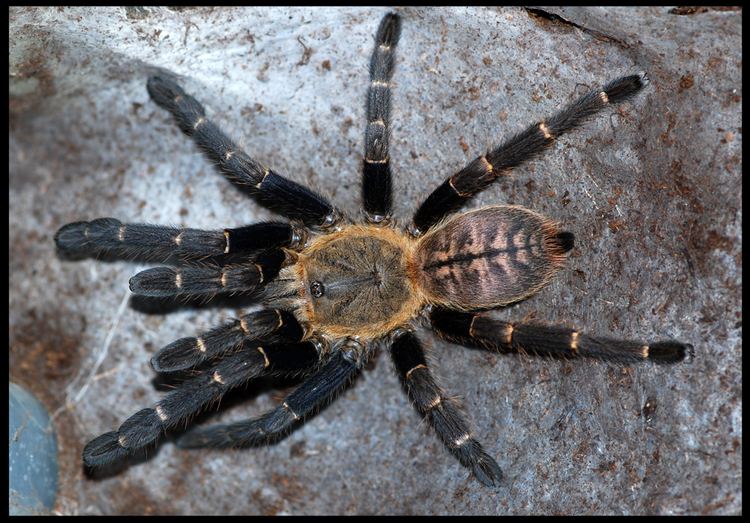Order Araneae Higher classification Tarantula | Rank Subfamily | |
 | ||
Similar Tarantula, Haplopelma, Ornithoctonus, Cyriopagopus, Lampropelma | ||
Ornithoctoninae sp orange fringed
Ornithoctoninae, also known as earth tigers, are a subfamily of Asian tarantulas, which were first erected in 1895 by Reginald Innes Pocock on basis of the genotype Ornithoctonus andersoni described in 1892 from former Burma, now Myanmar.
Contents
- Ornithoctoninae sp orange fringed
- Ornithoctoninae sp kalimantan feeding
- Care of Ornithoctoninae kept as pets
- Genera and species of Ornithoctoninae
- References
The Ornithoctoninae is a theraphosid sub-family, which are widely distributed in Asia from Myanmar to South China in the north and as far as to Halmahera in the Indonesian archipelago in the south, and in all the ranges in between. Most species in the subfamily live fossorially in burrows, though there are several species which are living arboreally in trees. They are known as defensive spiders; when disturbed they will quickly retreat into their burrows or dig themselves into the soil. When neither is a possibility, they will assume a defensive posture. When provoked, they will strike the aggressor repeatedly with the anterior legs; if the aggressor does not retreat these spiders has been known to bite. Though not deadly, the effects of the venom can be very unpleasant including pain, swelling and arthritis like stiffness in the joints of the extremity affected.

The theraphosid subfamily Ornithoctoninae is defined by the following combination of characters. Presence of retrolateral scopula of filiform setae on the cheliceral base. a small row of larger filiform paddle setae retrolaterally ventro-basally in connection to the retrolateral cheliceral scopula. Arrangement of stridulatory spines prolaterally on maxilla. The character of retrolateral scopula of filiform setae on the cheliceral base is shared by the African subfamily Harpactirinae, but the Ornithoctoninae can be distinguished from the Harpactirinae by the geographic distribution range and the presence of the other characters mentioned, which are lacking in the Harpactirinae.

Ornithoctoninae sp kalimantan feeding
Care of Ornithoctoninae kept as pets

Specimens from the genera Haplopelma, Cyriopagopus, and Ornithoctonus are frequently kept as pets. The most commonly kept species are: Haplopelma albostriatum, H. hainanum, H. lividum, H. longipes, H. minax, H. schmidti, Ornithoctonus aureotibialis and Cyriopagopus schioedtei. More species are kept and new species enters the hobby every now and then, but most of this material needs to be properly identified or described.

Haplopelma and Ornithoctonus are burrow-dwellers. A high soil level (at least 15 cm, or 6") is necessary for them to be able to successfully dig burrows. This behavior is described by von Wirth and Huber in the "Haplopelma-tanks" (2002, 2004), which also recommends frequently watering the cage. Alternatively, one can create a "fauna box" by filling up a cage (as high as possible, up to a few centimeters below the top) with potting soil, one can place (as high as possible) a "fauna box", which one fills up with potting soil, coconut compost, or a peat moss mixture. However this method is less advantageous than the method recommended in the Haplopelma Spezialbecken. Temperatures of 23°–25 °C are sufficient.

One should accommodate Cyriopagopus in a terrarium for tree-dwellers, but one should also include a high soil level, since the animals do like to dig into the soil, especially as juveniles.
Genera and species of Ornithoctoninae
A list of known species in Ornithoctoninae, sorted by genera:
Citharognathus (Pocock, 1895)
Type species: Citharognathus hosei
Cyriopagopus (Simon, 1887) [Senior synonym of Melognathus {Chamberlin, 1917}]
Type species: Cyriopagopus paganus
Haplopelma (Simon, 1892) [Senior synonym of Melopoeus {Pocock, 1895}]
Type species: Haplopelma doriae
Transferred to other genera:
Haplopelma chrysothrix (Schmidt & Samm, 2005) → Ornithoctonus aureotibialis
Haplopelma costale → Ornithoctonus costalis
In synonymy:
Haplopelma huwenum (Wang, Peng & Xie, 1993) = Haplopelma schmidti
Lampropelma (Simon, 1892)
Type species: Lampropelma nigerrimum
Ornithoctonus (Pocock, 1892)
Type species: Ornithoctonus andersoni
Transferred to other genera:
Ornithoctonus gadgili (Tikader, 1977) → Poecilotheria regalis
Ornithoctonus hainanus → Haplopelma hainanum
Ornithoctonus huwenus (Wang, Peng & Xie, 1993) → Haplopelma schmidti
Phormingochilus (Pocock, 1895)
Type species: Phormingochilus everetti
